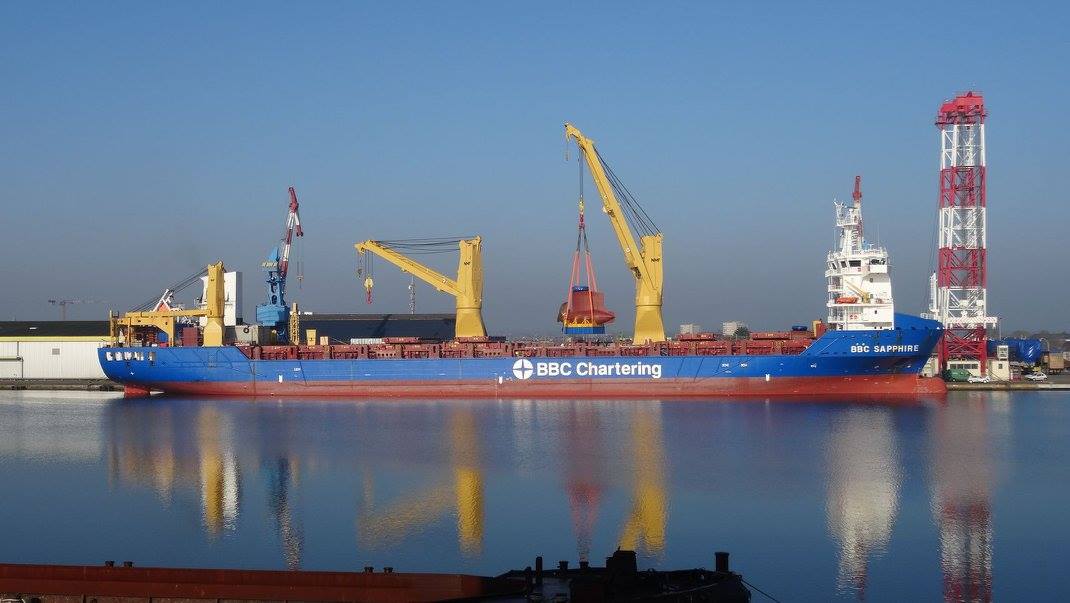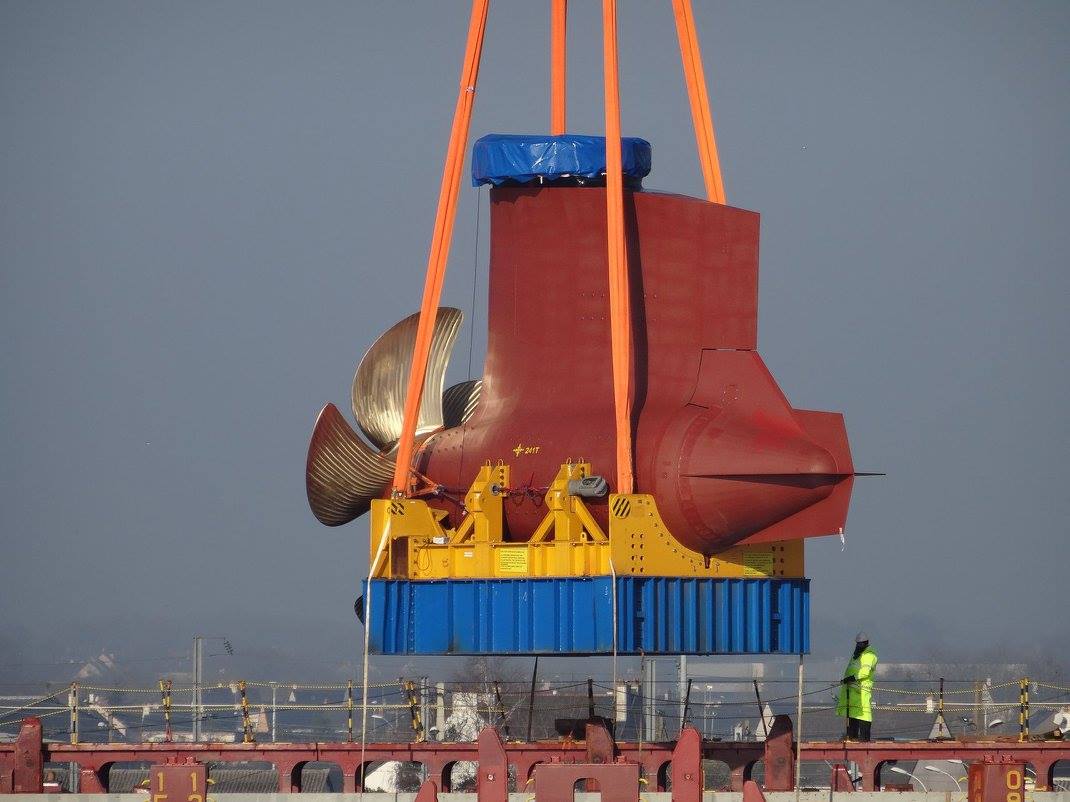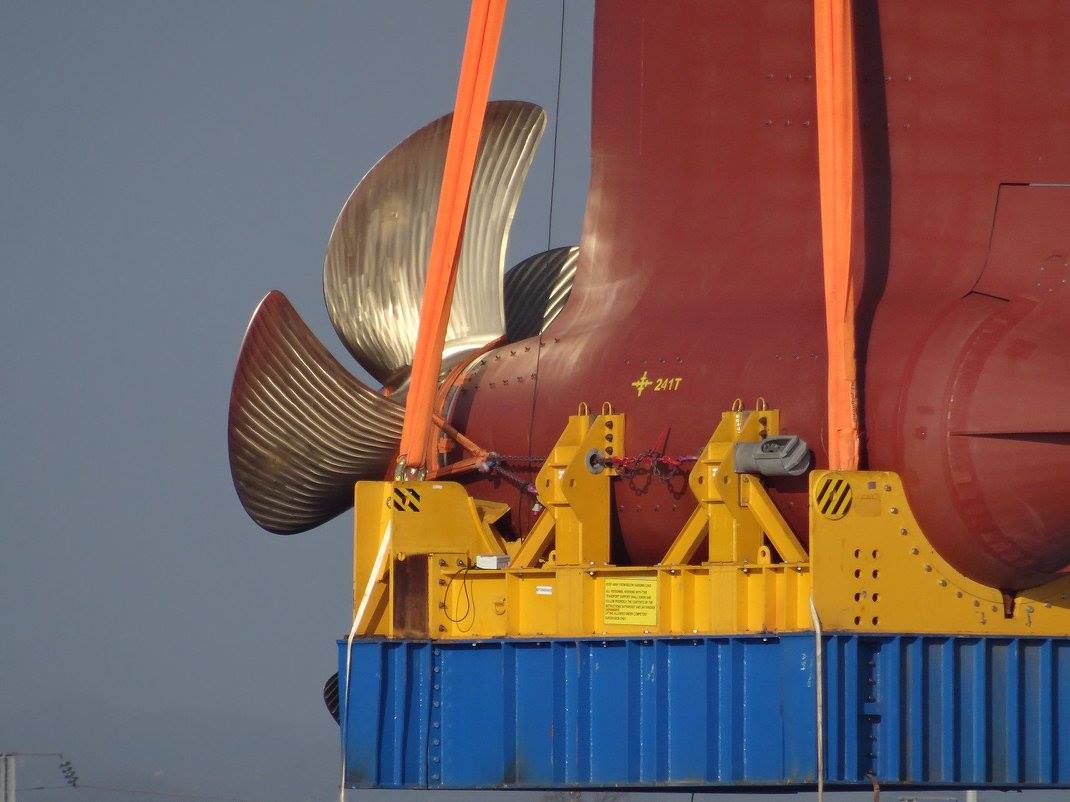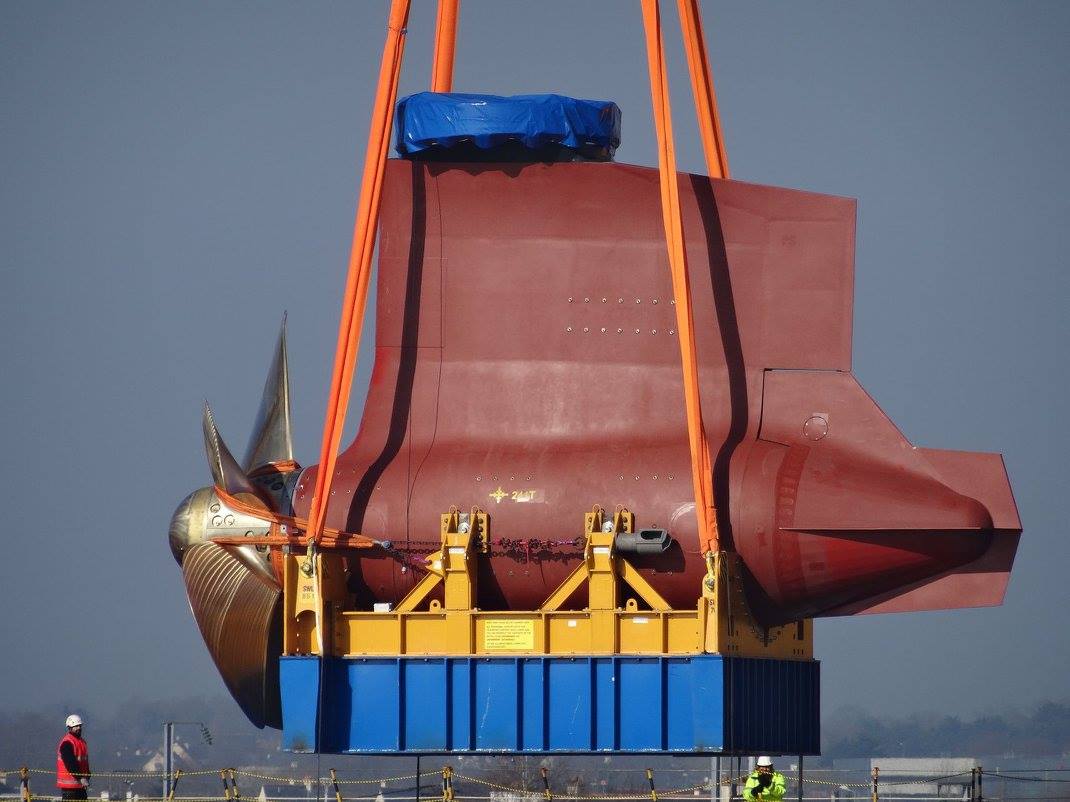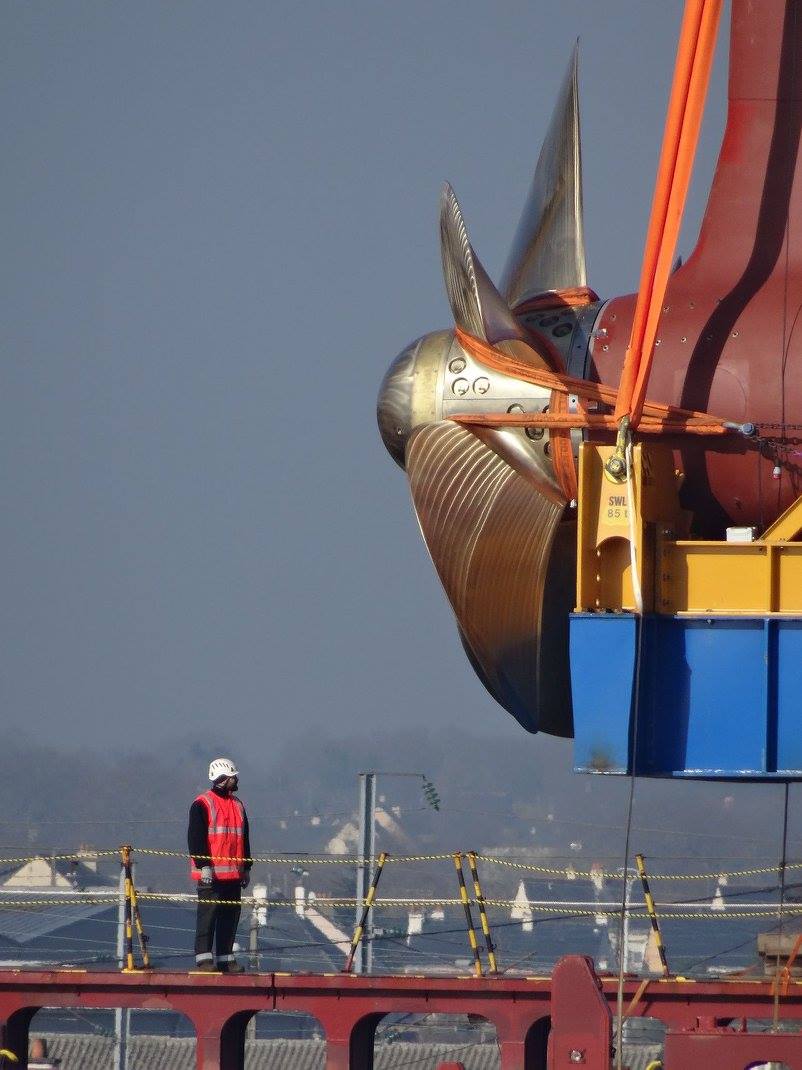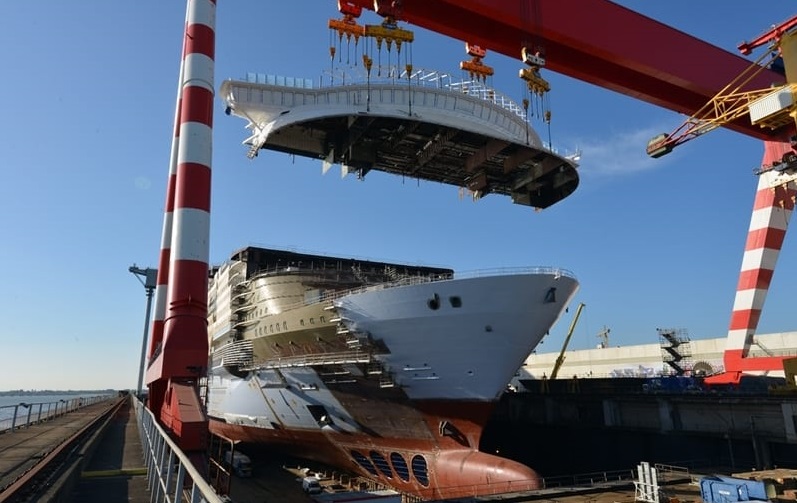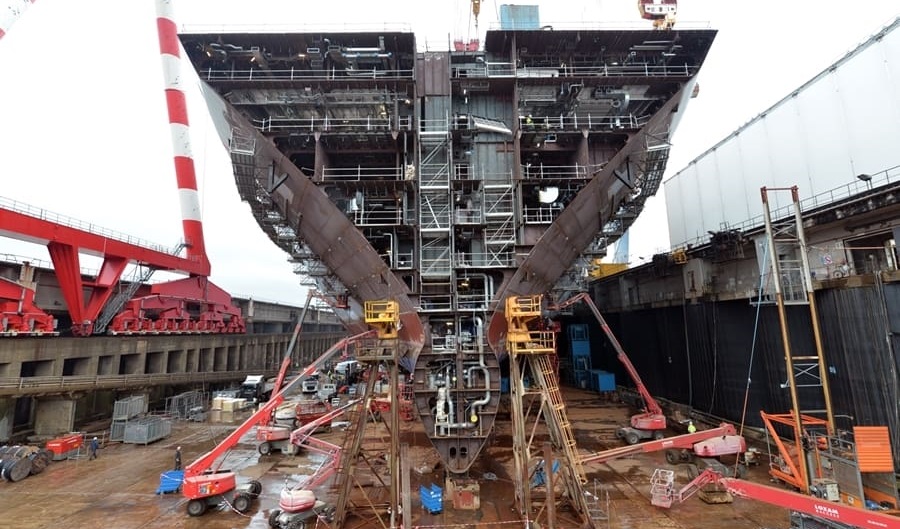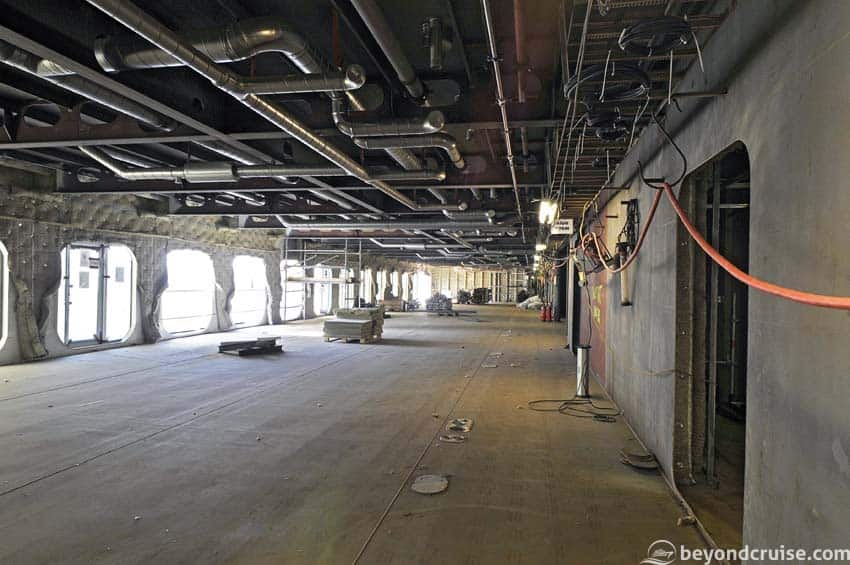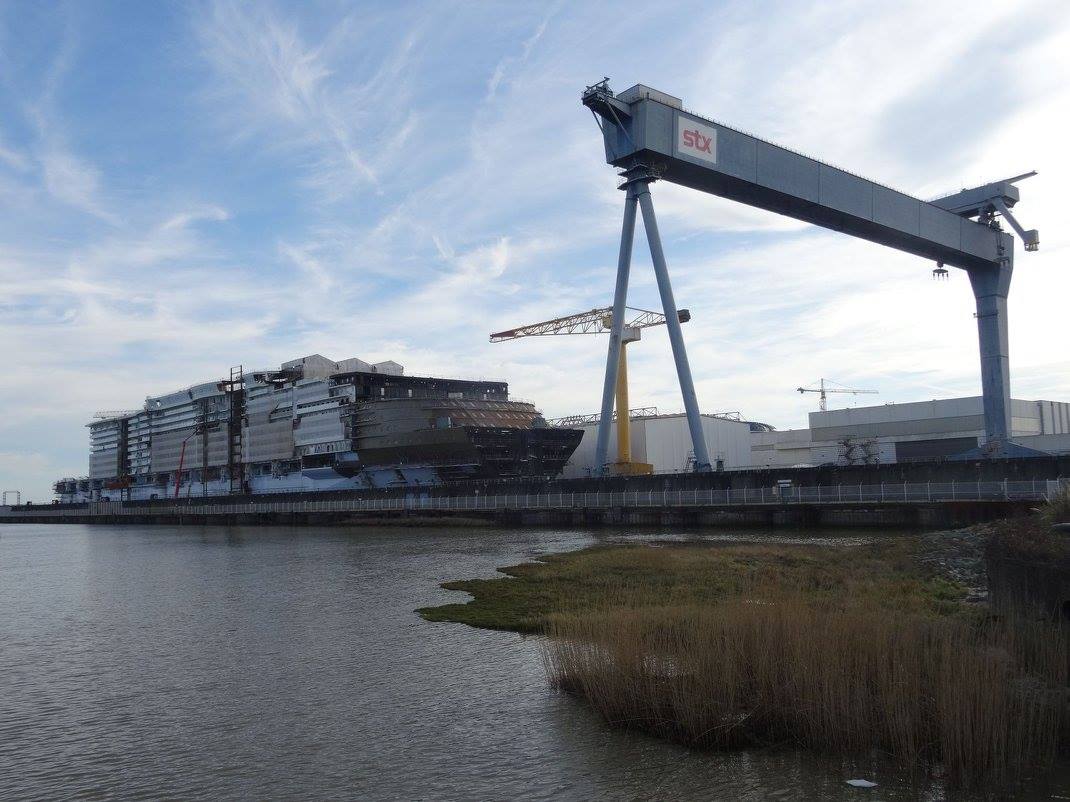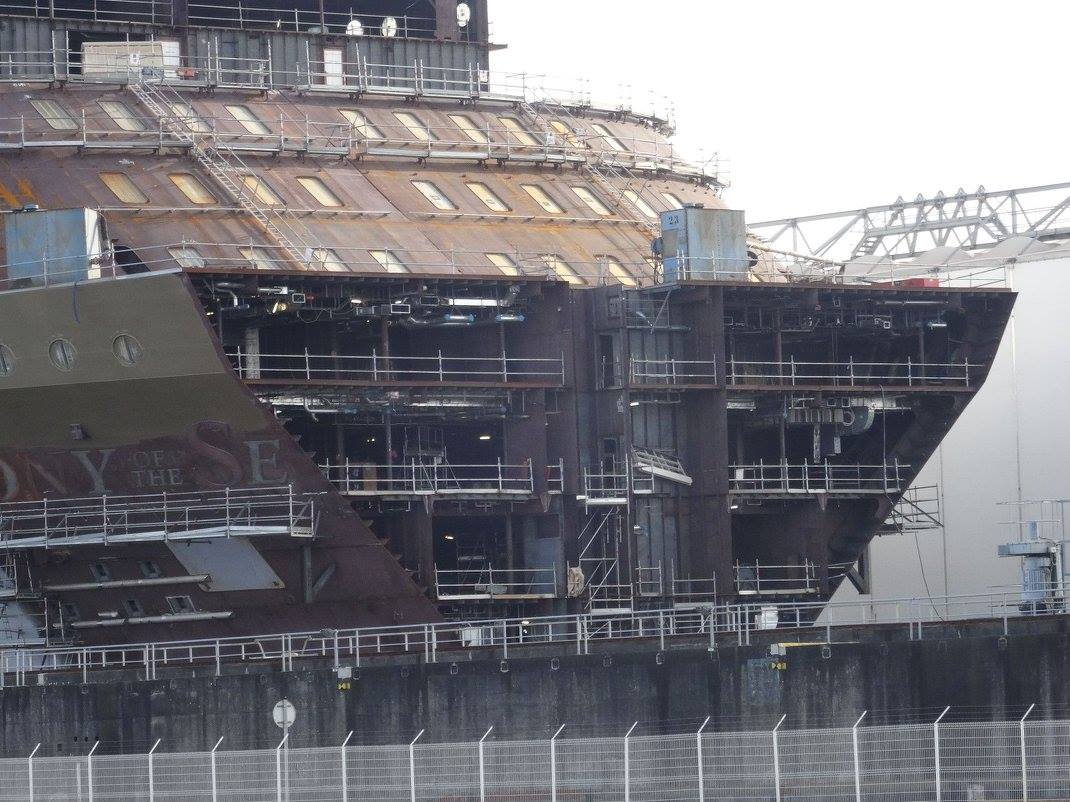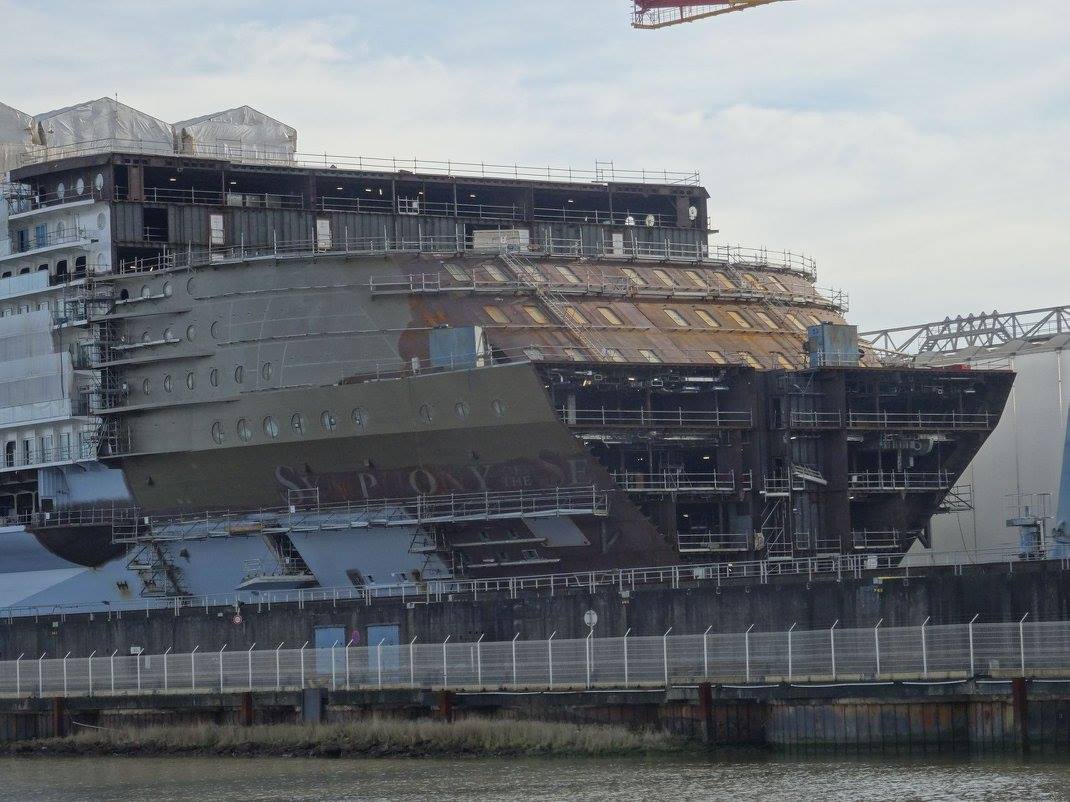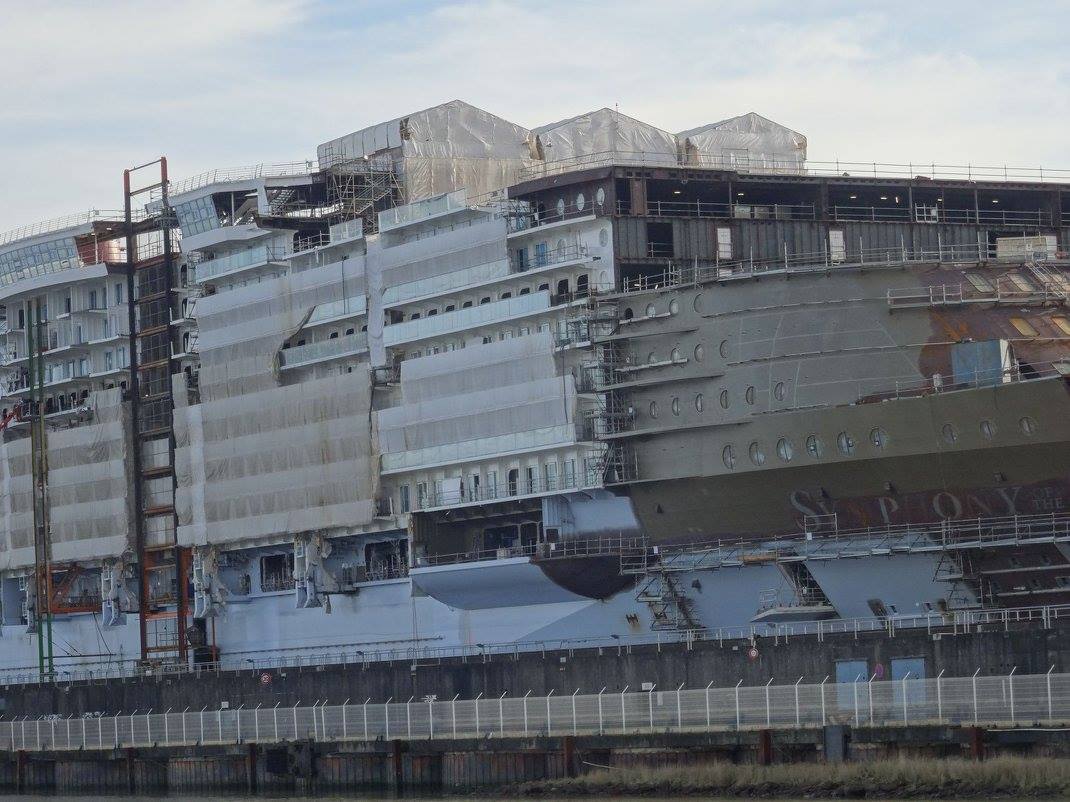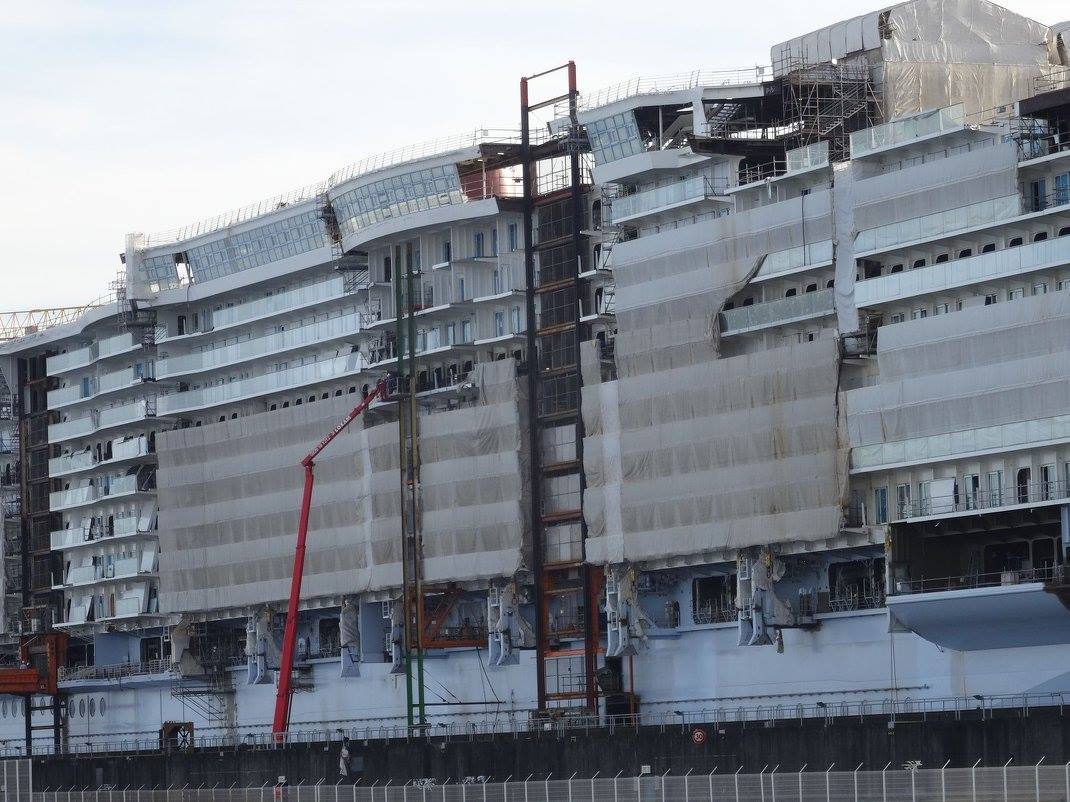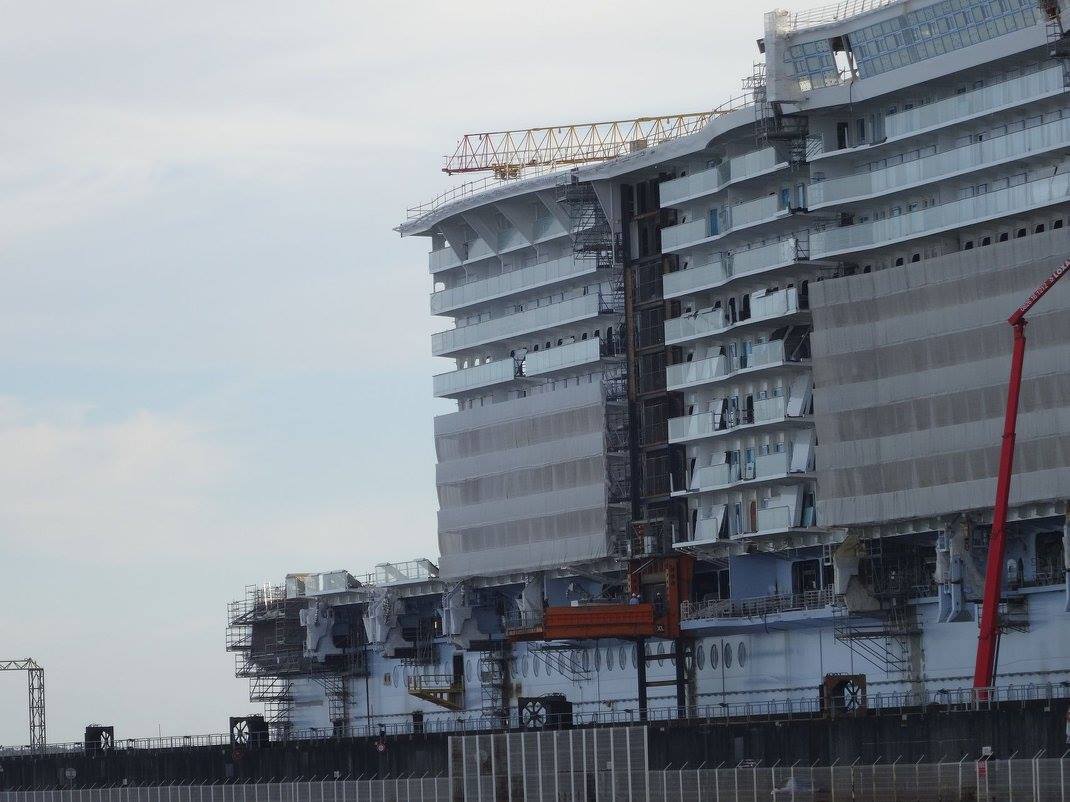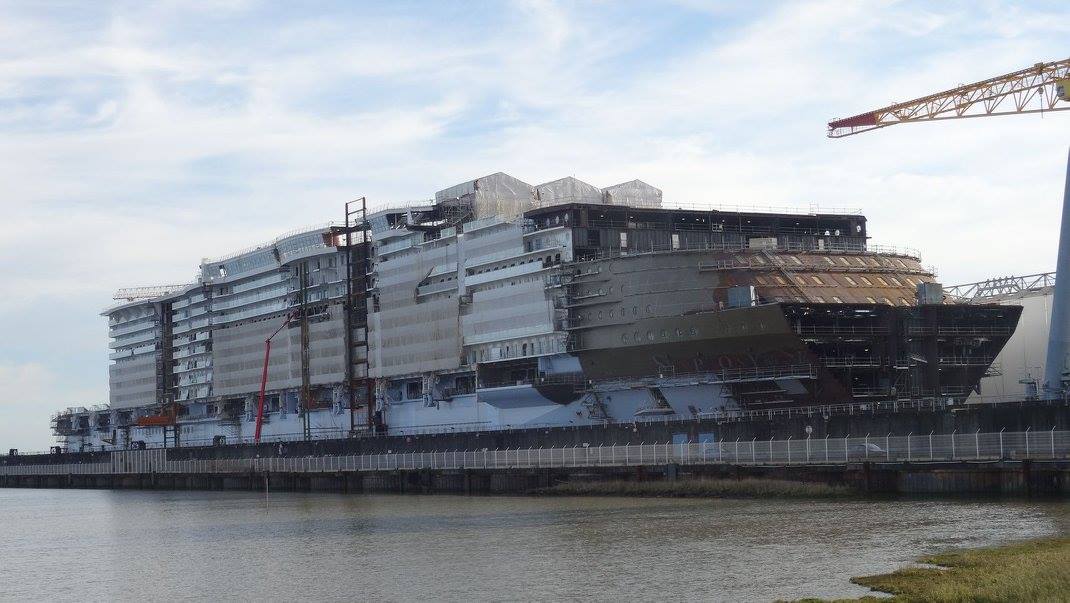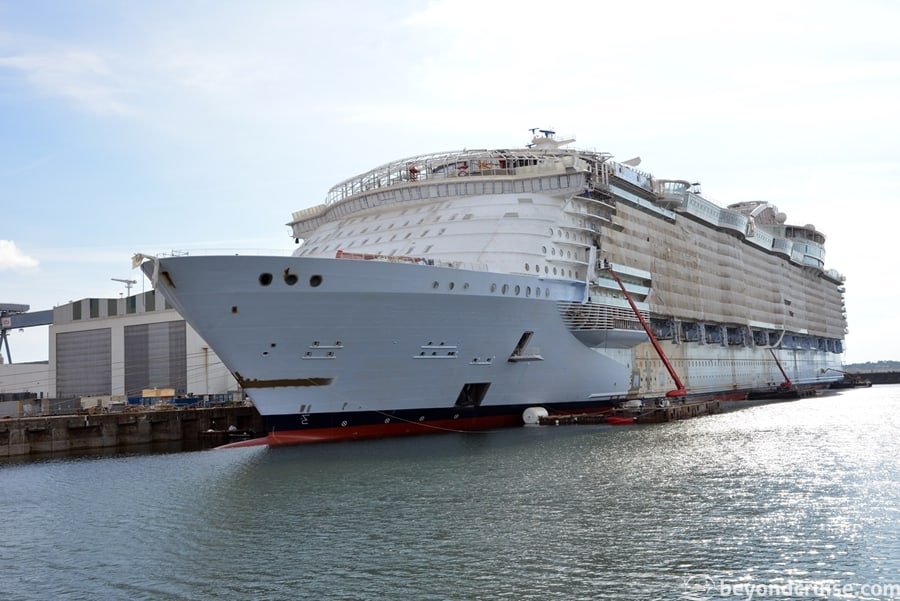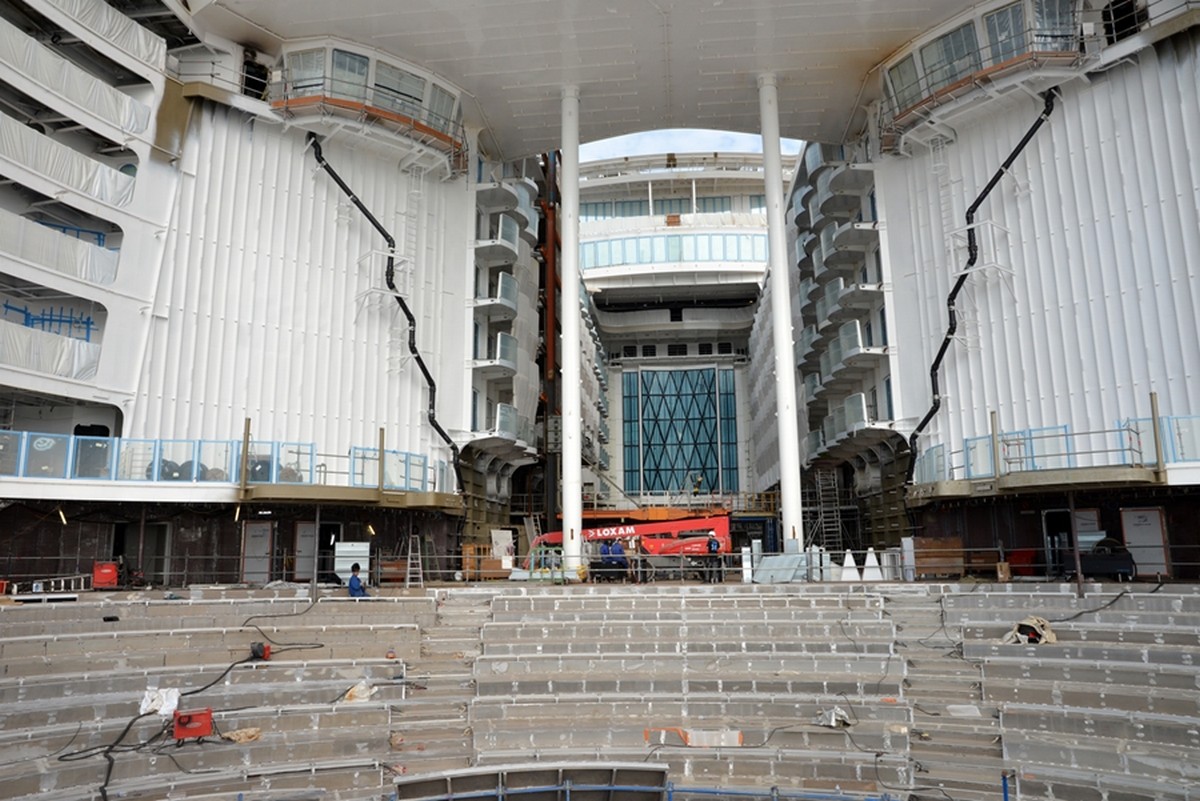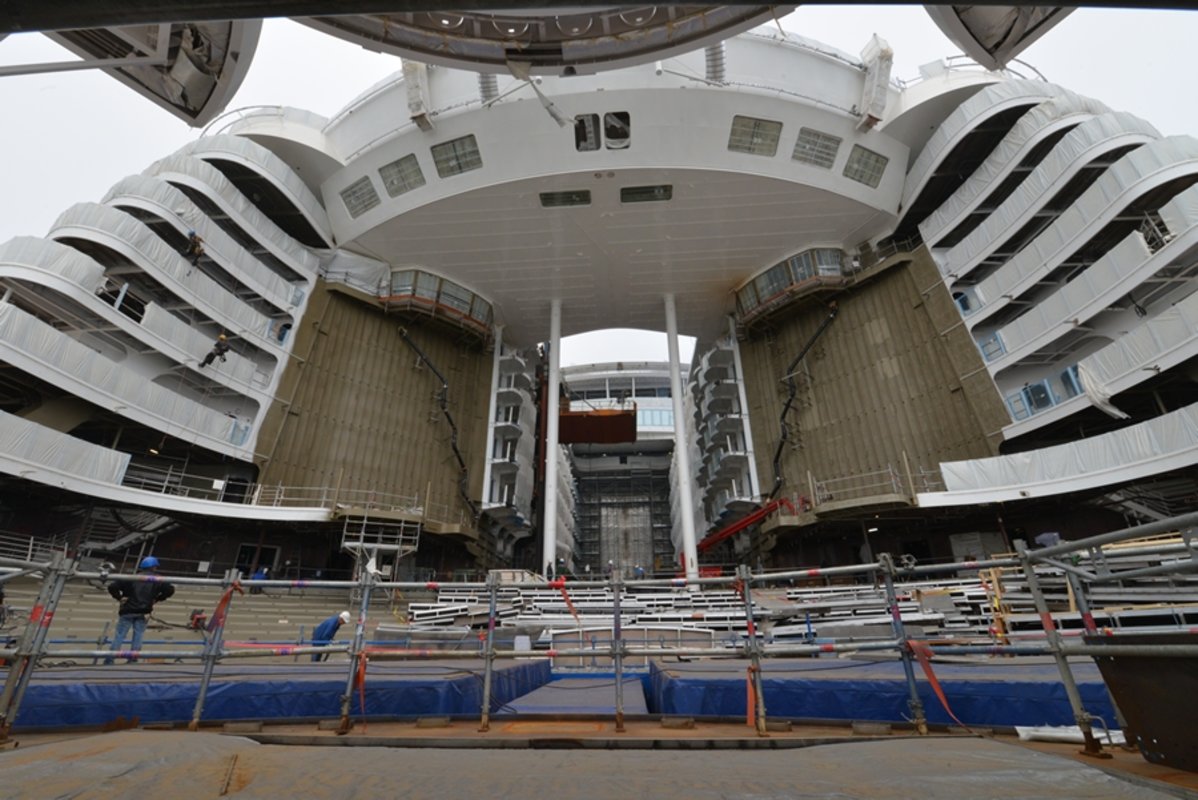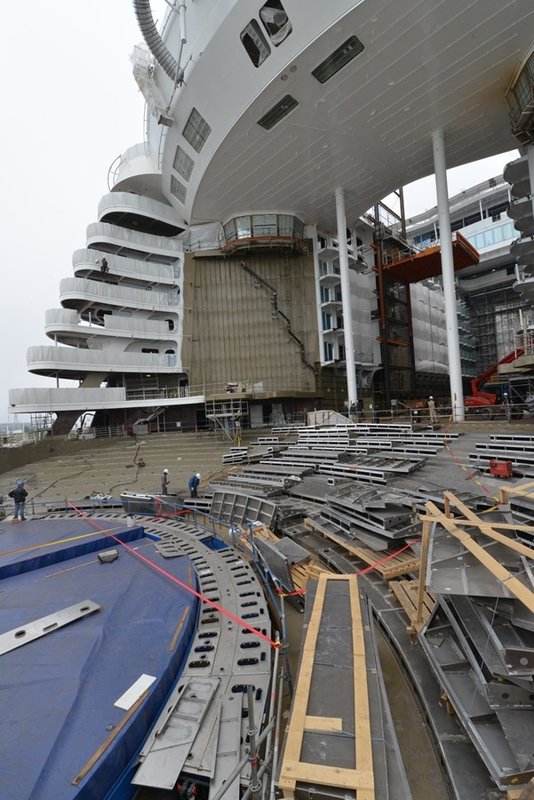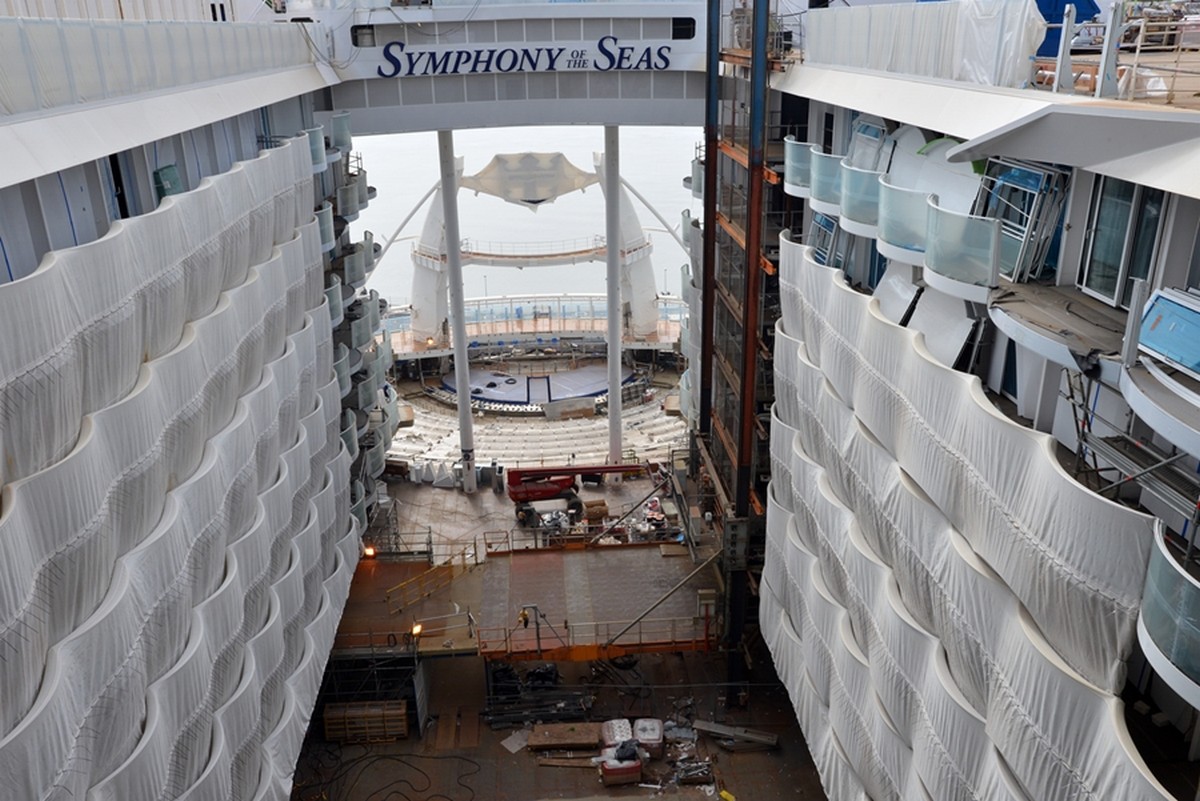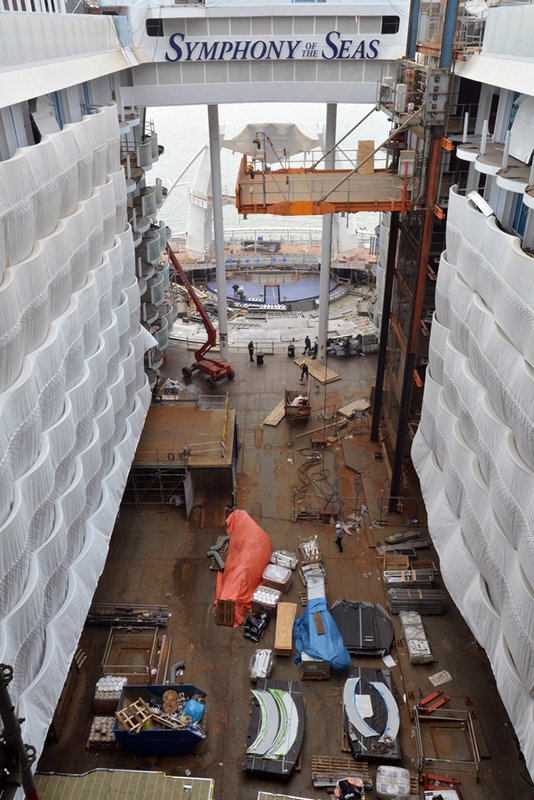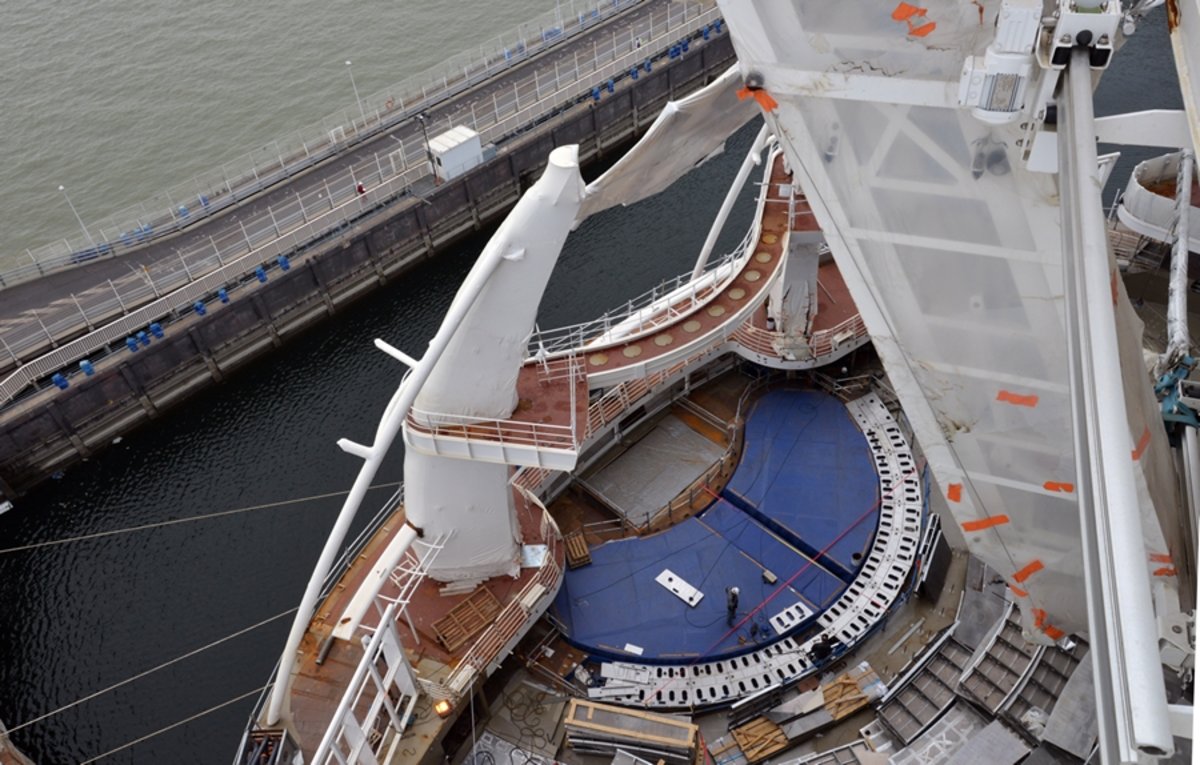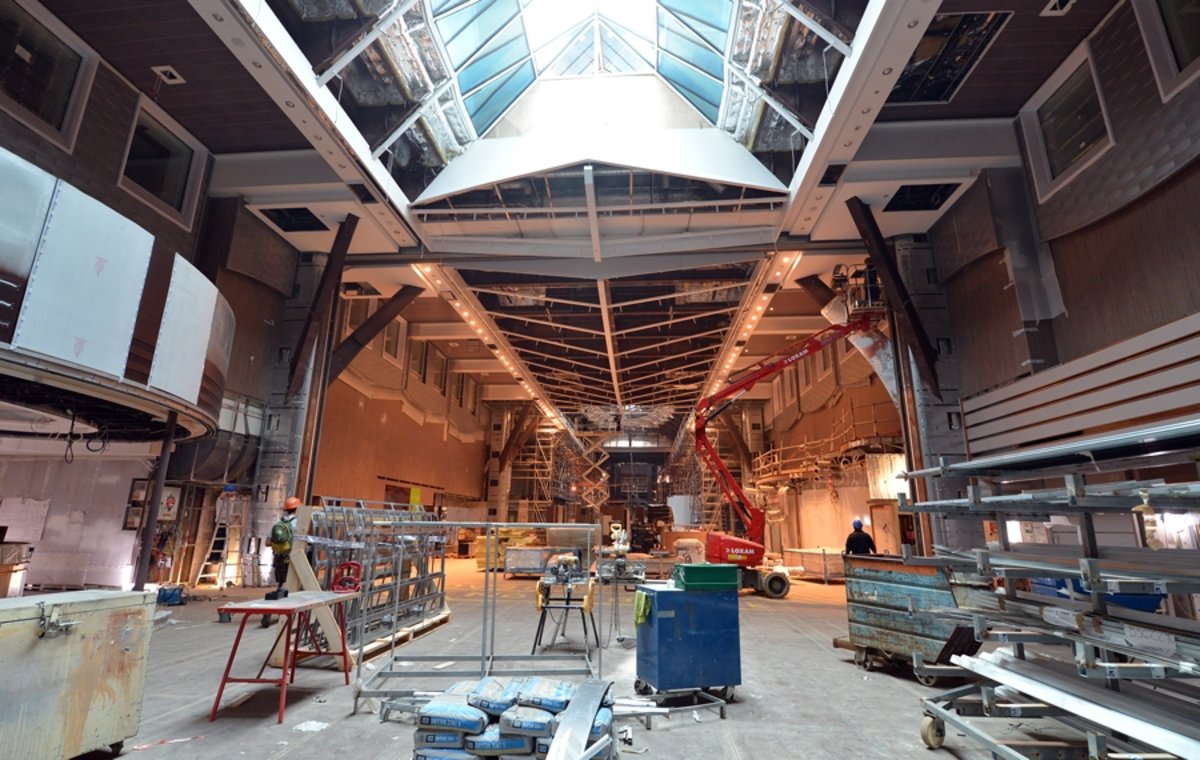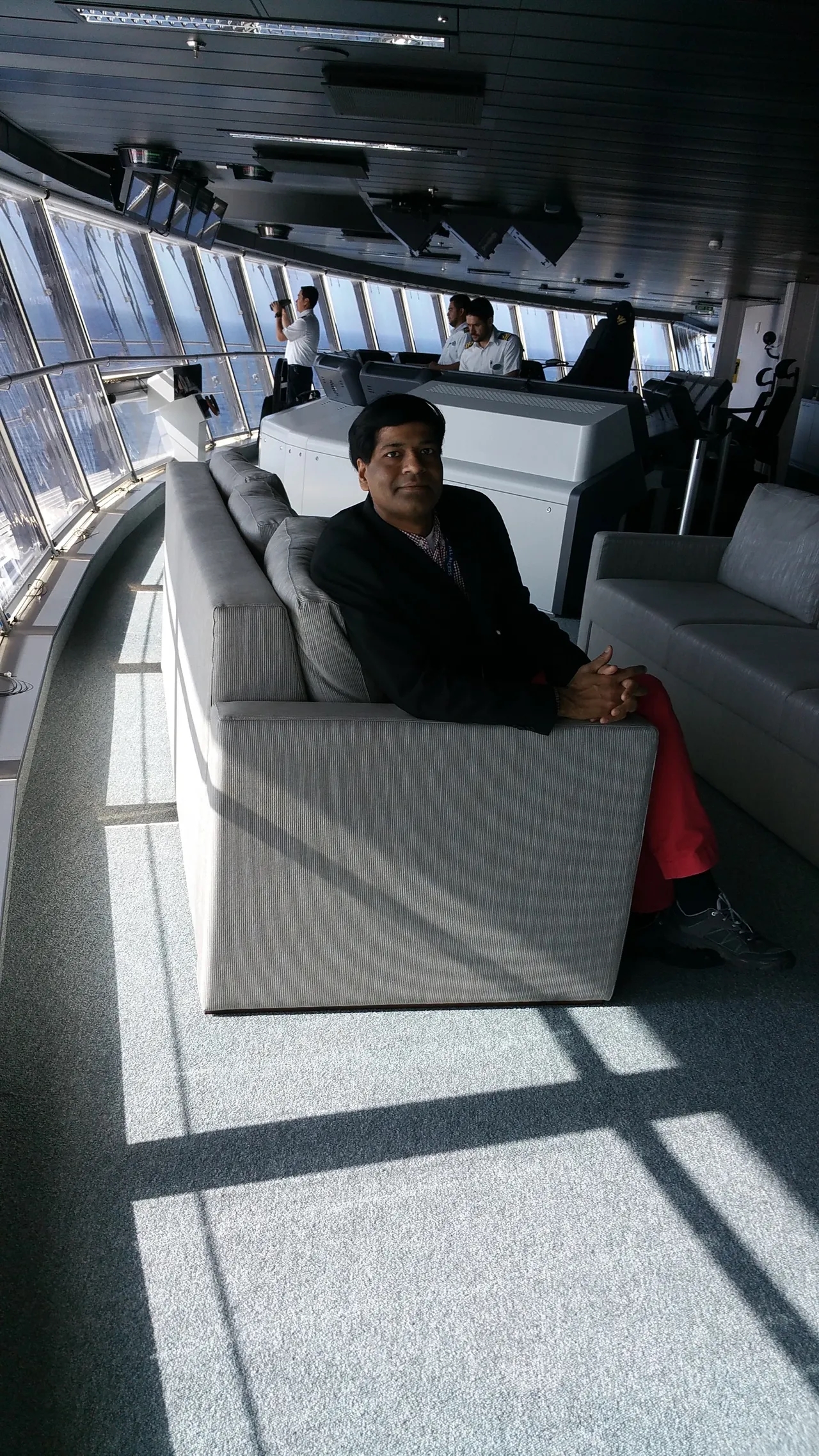
View from the eye of the Ship Captain ! From the BRIDGE of the world¨s LARGEST, LATEST & BEST SHIP ! It is a very unique experience to visit the whole of the ship and understand the back office operational areas like cooking, kitchen, fridges, laundry areas of the ship including ´´The BRIDGE´´. THE BRIDGE of the ship is the area from where the key crew members of the ship including the Captain of the Ship operate – and the area from where the whole ship is operated, controlled and manouvred.This is one of my highest, nostalgic & most magical moments in my life – being on the bridge of the world´s largest, latest & best ship !

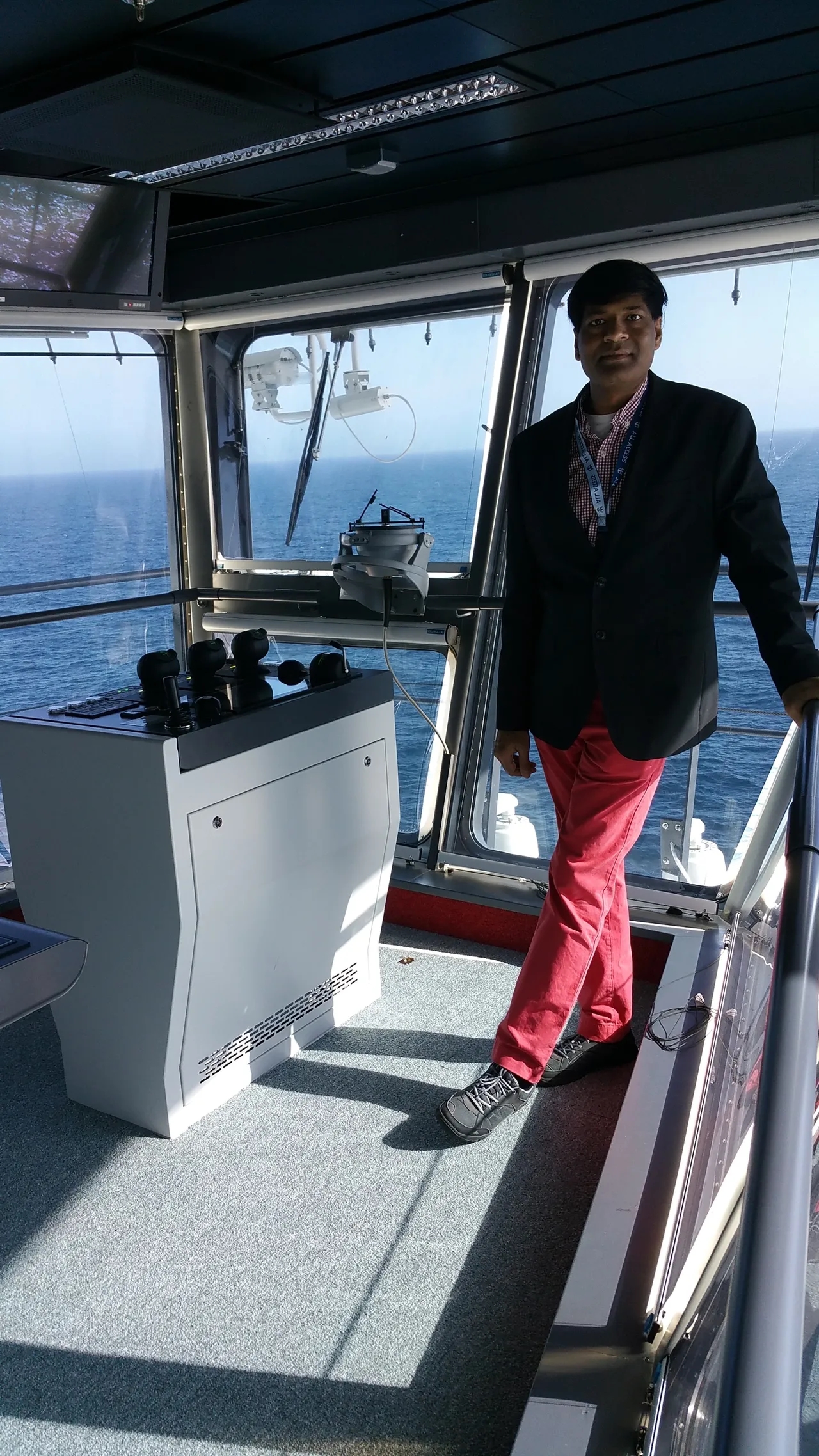
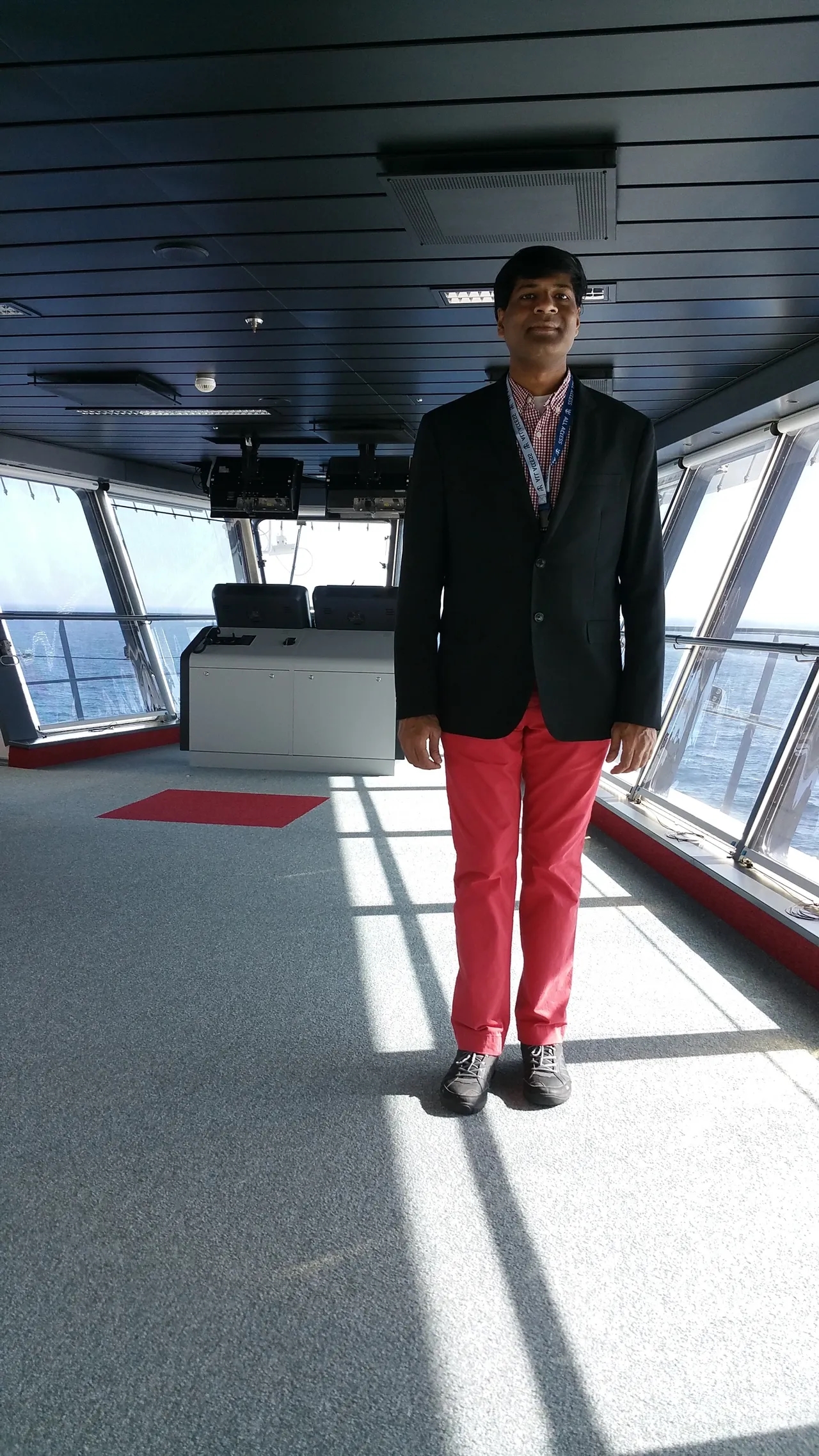
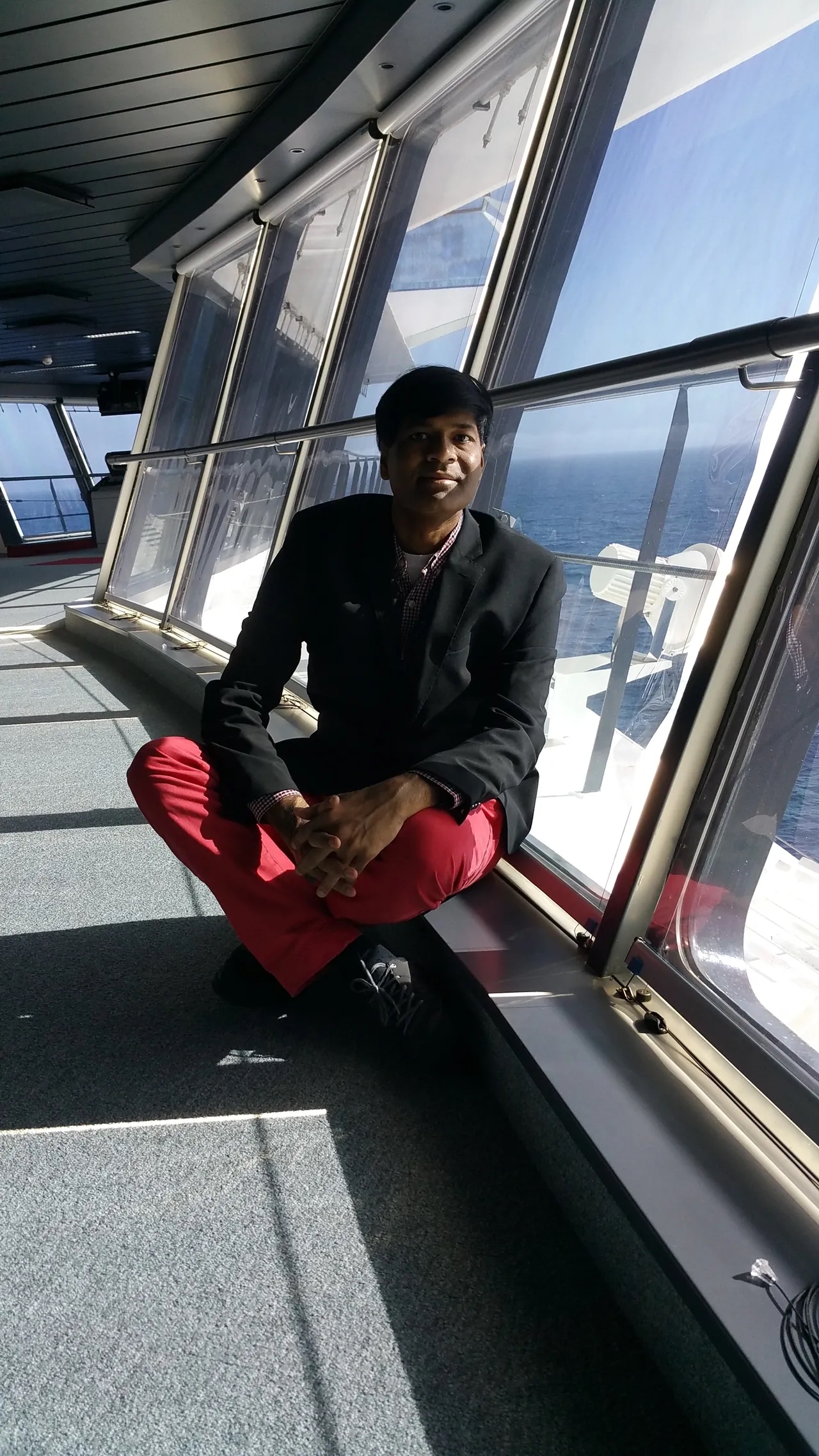
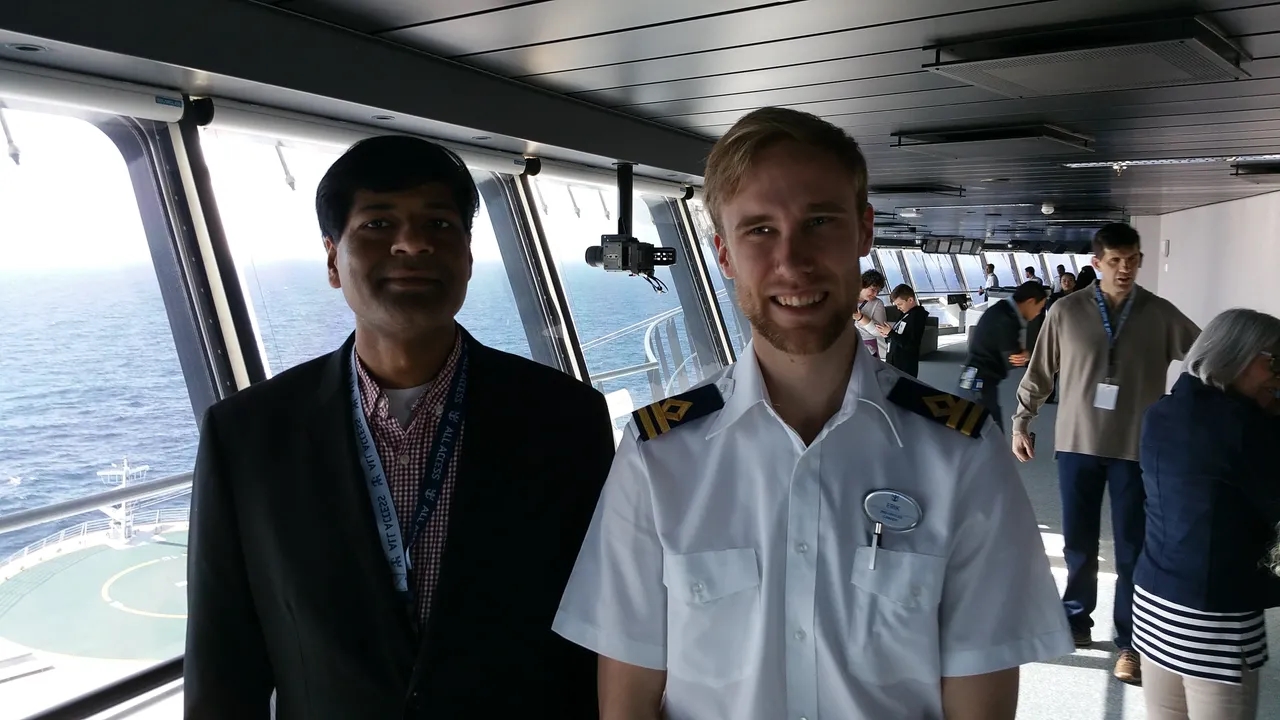
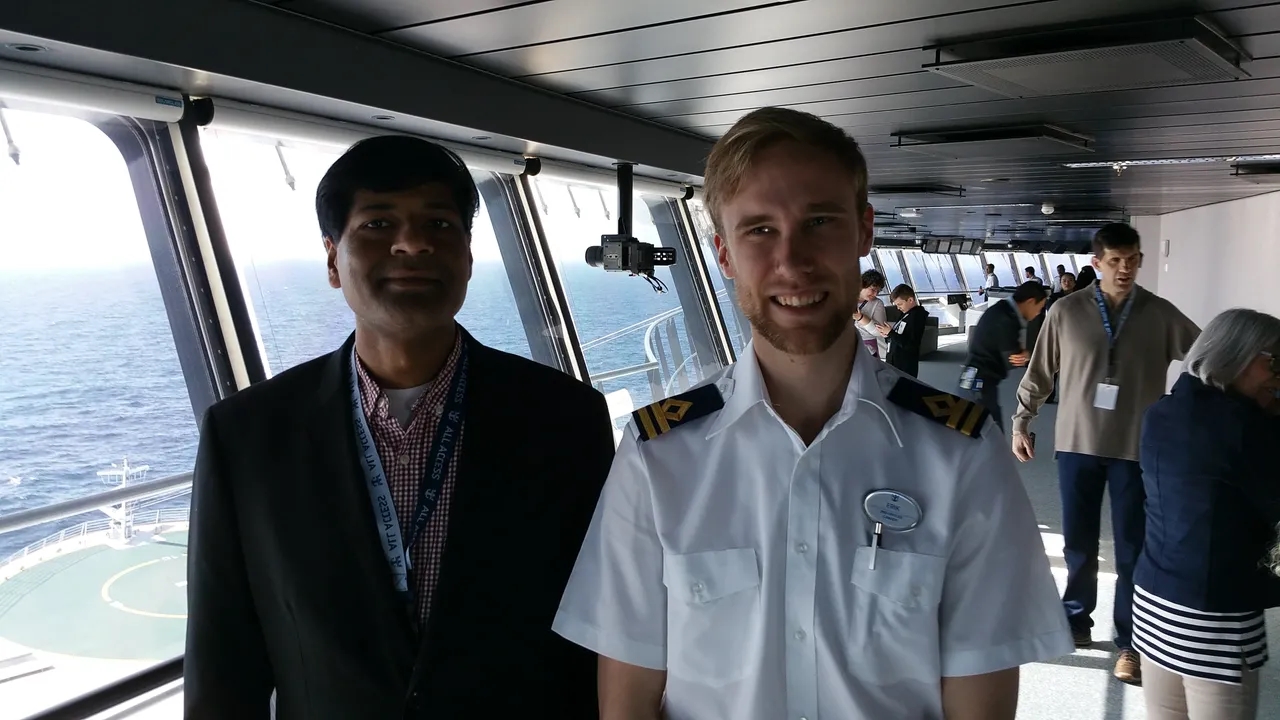
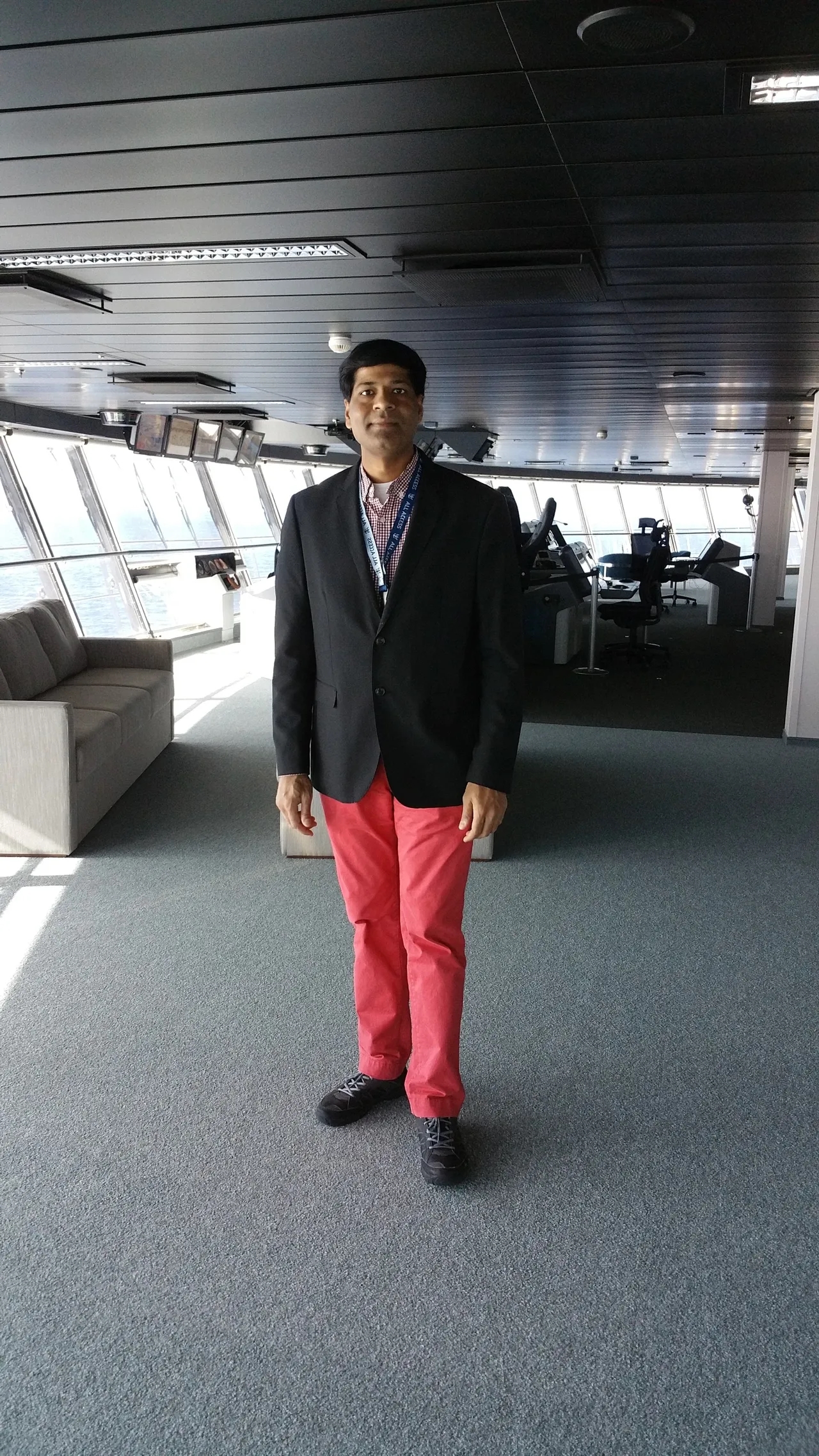
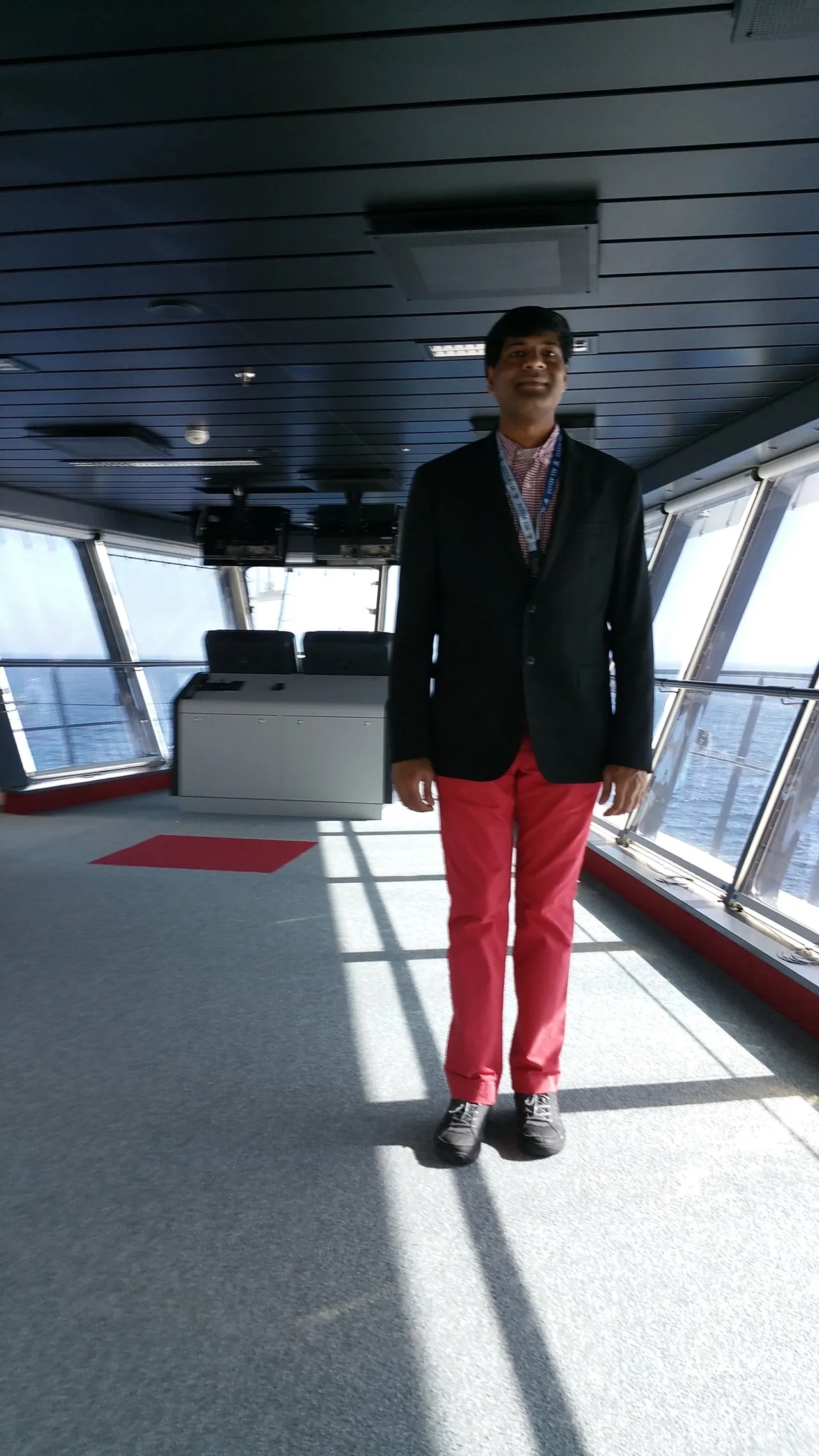
General characteristics
- Tonnage : 228,081 GT (258,794 NT)
- Length : 361.011 m (1,184.42 ft)
- Beam : 47.448 m (155.67 ft)
- Waterline : 66 m (215.5 ft) max beam
- Height : 72.5 m (238 ft)
- Draught : 9.322 m (30.6 ft)
- Decks : 18
Installed power
- 4 × 14,400 kW (19,300 hp) Wärtsilä 12V46F
- 2 × 19,200 kW (25,700 hp) Wärtsilä 16V46F
Propulsion
- Diesel-electric; 3 × 20 MW (27,000 hp) ABBAzipod, all azimuthing
Bow thrusters
- 4 × 5.5 MW (7,400 hp) Wärtsilä WTT-55
Speed
- 22 knots (41 km/h; 25 mph)
Cruising Capacity
- 5,518 passengers at double occupancy
- 6,680 passengers maximum
- Crew : 2,200
SYMPHONY OF THE SEAS
SHIP BUILDING & CONSTRUCTION
THE 10 STAGES OF THE
SYMPHONY OF THE SEAS
1. THE INITIAL ORDER
SYMPHONY OF THE SEAS ORDERED
2014 / MAY 9
- Everything starts with an order
- Shipyards around the world are pretty busy but not quite at a stage yet where rival cruise lines are buying construction slots “just in case” then selling them as airlines do with planes
- Generally, a shipyard will have several ships being built at the same time, all in various different stages and many ships placed in their order books as either confirmed or as ‘an option’ – which allows the cruise line to cancel or postpone the build if necessary
- It is at this stage that the cruise line will announce they’ve placed an order for a new ship and it is usually around 3 – 4 years away
- No name or any details is given at this stage, just the tonnage, possible class of ship (for example a sister ship or a brand new design) and usually the passenger capacity
2. THE STEEL-CUTTING CEREMONY
SYMPHONY OF THE SEAS STEEL CUTTING
2015 / FEBRUARY 3
- By the time we get to the steel-cutting ceremony, the cruise line is starting to generate some news & press about their new ship
- At this point, the ship is usually given a name publicly, although in some instances she may still only have a build number which is referenced on her hull
- The first steel is cut in front of senior management from the cruise line, the shipyard and the press
- What you’ll actually see doesn’t really resemble anything but laser-cut steel at this point !
- This process continues for months as the shipyard creates lots of pieces of steel all cut into different shapes and sizes which are then welded together to make sections or ‘blocks’
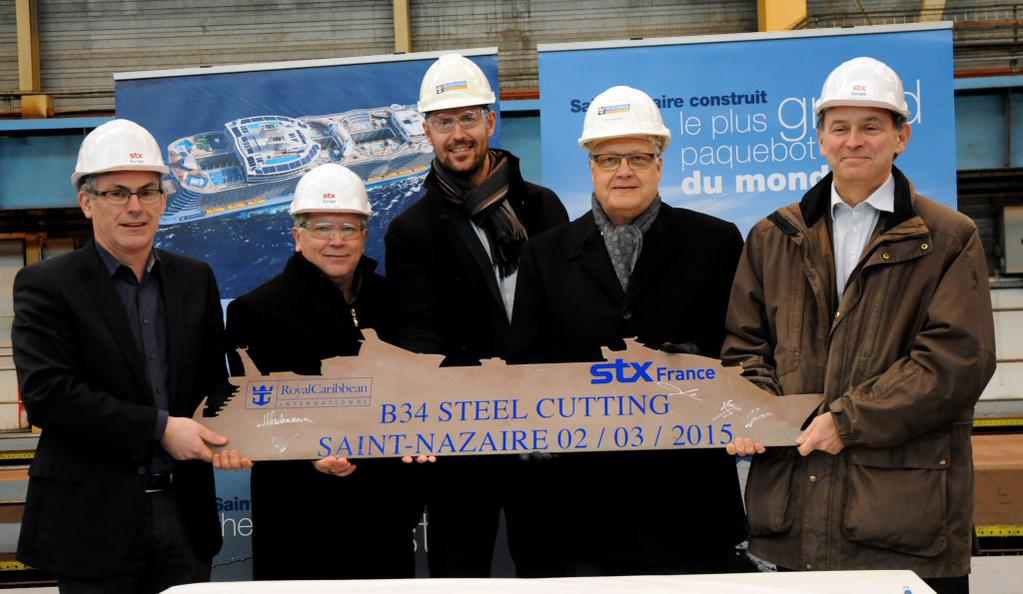
3. THE KEEL – LAYING CEREMONY
SYMPHONY OF THE SEAS : KEEL LAID
2015 / OCTOBER 29
- The next important part of building a ship is the laying of the keel
- The keel is the lowest (or bottom) of any ship and will be part of the first block that is lowered by massive cranes into the dry dock or basin as it is sometimes called
- Laying the keel or laying down is the formal recognition of the start of a ship’s construction
- It is often marked with a ceremony attended by dignitaries from the shipbuilding company and the ultimate owners of the ship
- Keel laying is one of the four specially celebrated events in the life of a ship ; the others are launching, commissioning, and decommissioning
- In earlier times, the event recognized as the keel laying was the initial placement of the central timber making up the backbone of a vessel, called the keel
- As steel ships replaced wooden ones, the central timber gave way to a central steel beam
- Modern ships are now largely built in a series of pre-fabricated, complete hull sections rather than being built around a single keel
- The event recognized as the keel laying is the first joining of modular components, or the lowering of the first module into place in the building dock
- It is now often called “keel authentication”, and is the ceremonial beginning of the ship’s life, although some modules may have been started months before that stage of construction
KEEL LAYING CEREMONY : TRADITIONS
- Keel-related traditions from the times of wooden ships are said to bring luck to the ship during construction and to the captain and crew during her later life
- They include placing a newly minted coin under the keel and constructing the ship over it, having the youngest apprentice place the coin, and when the ship is finished, presenting the owners with the oak block on which the keel is laid
- The tradition of the placement of coins derives from the mast stepping custom of placing coins under the mast and is believed to date back to Ancient Greece or Ancient Rome and were intended to “pay the ferryman” to convey the souls of the dead across the River Styx should the ship sink
- At this point, there is usually a coin laying ceremony
- Specially commissioned gold coins are laid in the keel block to symbolise good luck. Sometimes they are welded in and at other times, they are just placed in and then retrieved later on and then used in a mast stepping ceremony, where the coins are welded under the bottom of the main ship’s mast
- These days cruise ships don’t have a mast like sailing ships and therefore they are placed under or attached to the very bottom of the radar mast and left on display
- The coin ceremony is carried out by the Godmother (Madrina) of the ship
- The Godmother at this point isn’t the same as the official Godmother that will name the ship when she is finished
- Instead, it may be someone important from the cruise line or occasionally two people, one from the shipyard and another from the cruise line
- The keel is then laid with exact precision, usually using GPS coordinates which are accurate to the centimetre. We now have (part) of the bottom of the new cruise ship !
- As modern ships are now built by block (like Lego!), there is an ongoing process in the shipyard
- Engineers will construct new blocks in one area of the shipyard whilst in another area large cranes will lower completed blocks into the dry dock and more engineers will weld together the large sections
- These sections can commonly weigh in at 150 tonnes or more with ease
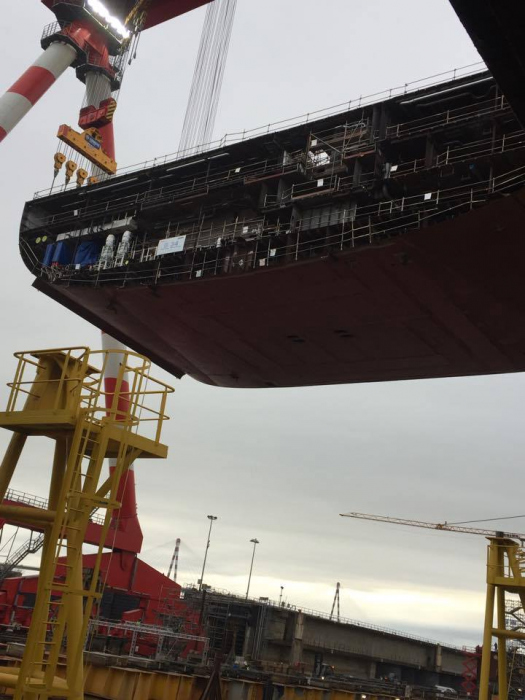
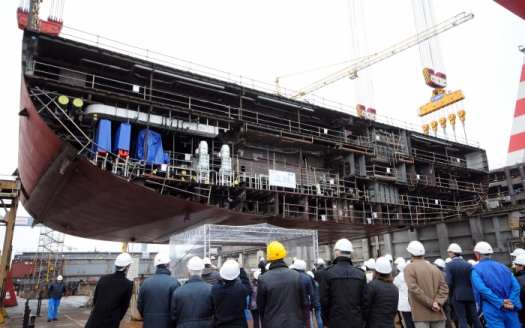
- Eventually, you end up with something on the outside looking like a cruise ship
- Although the inside is generally bare at this point apart from structural things like decks and staircases
- Temporary lifts will be fitted at the side of the ship and large equipment and more steel will be either lifted or craned onto the ship
- From the outside, your ship will look a familiar shape, but her paintwork will be patchy in places and she may not have any glass or outdoor facilities fitted yet
- As the months progress the ship has her azipods fitted (propellers fitted to large shafts which can rotate 360 degrees allowing the ship to move in any direction) and she is now pretty much waterproof, at least from below
4. THE FLOAT OUT CEREMONY
SYMPHONY OF THE SEAS : FLOATED OUT
2017 / JUNE 09
- Float-out is the process in modern shipbuilding that follows the keel laying and precedes the fitting-out process
- It is analogous to launching a ship, a specific process that has largely been discontinued in modern shipbuilding
- Both floating-out and launching are the times when the ship leaves dry land and becomes waterborne for the first time, and often take place during ceremonies celebrating and commemorating that event
- The Float Out is a large milestone in any ship’s build
- At this point, there are 100s of workers working on every area of the ship, sometimes in rolling 24/7 shifts depending on how quick the cruise line wants their ship and how many ships the shipyard has on their order books !
- By now, cabins – which are usually made in a factory nearby and prefabricated are literally craned or lifted onto the ship and then slotted in next to each other like jigsaw pieces
- The plumbing and wiring are connected to each cabin or “pod” and it is ready to go – just needing bedding and other small furniture items adding !
- The ship gets to a point where it is ready to be moved out of the dry dock for the first time
- Press are gathered, cruise line management, workers who have helped build the ship and even some local dignitaries may also attend
- There is a speech, generally by the Chief Engineer and he gives thanks to the builders and talks about the milestones they completed and then the shipyard and cruise line representatives also give speeches
- Then, the Godmother (still not the official one that will name it!) will smash a bottle of champagne over the bow of the ship and everyone will gather at the rear of the ship as the dry dock is flooded for the first time
- Depending where the ship is being built, other maritime traditions may also take place – commonly a sample of the first water to touch the ship’s hull is collected and kept in a sealed bottle (called an ampoule)
- It is then presented to the Captain of the ship who will have it on display in his office near the Bridge
- Now the ship is floated out it will be moved to another part of the shipyard for the rest of the fit-out
- The fit-out can usually take months and the ship is usually alongside in the shipyard whilst the next ship to be built is being put together in the drydock
- The shipyard operates like a game of chess as ships move in and out of the drydock area and alongside to maximise productivity
- Prior to the large-scale use of drydocks (building or graving docks) for constructing ships, most vessels were constructed on a slipway, i.e. an inclined building platform sloping toward a body of water into which the ship would be launched
- The launching of ships has been largely replaced by the “floating” process
- After a ship is ordered for construction, its keel is laid in a drydock
- Construction of the ship continues in the dock, usually in the form of prefabricated units that are assembled
- After the empty hull has been substantially completed, sluice gates are opened and the drydock fills with water
- The dock gates are then opened and the ship is pulled out by tugboat to a berth where the remaining construction continues namely fitting out
- This usually includes further construction of the superstructure, attaching of masts and funnels, and the installation of equipment and furnishings
- The completed ship will usually return to drydock for installation of other equipment, propulsion parts, and the painting of its hull
5. THE SEA TRIALS
SYMPHONY OF THE SEAS : SEA TRIALS
2018 / FEBRUARY 15 – 18
- A sea trial is the testing phase of a watercraft (including boats, ships, and submarines)
- It is also referred to as a “shakedown cruise” by many naval personnel
- It is usually the last phase of construction and takes place on open water, and it can last from a few hours to many days
- Sea trials are conducted to measure a vessel’s performance and general seaworthiness
- Testing of a vessel’s speed, maneuverability, equipment and safety features are usually conducted
- Usually in attendance are technical representatives from the builder (and from builders of major systems), governing and certification officials, and representatives of the owners
- Successful sea trials subsequently lead to a vessel’s certification for commissioning and acceptance by its owner
- After the sea trials, the ship is brought back alongside or even into a drydock again whilst her internal fit out is completed and her hull and the rest of her external paintwork is completed
TYPICAL SEA TRIALS
- Sea trials are fairly standardized using technical bulletins published by ITTC, SNAME, BMT, regulatory agencies or the owners. They involve demonstrations and tests of the ship’s systems and performance
Speed trial
- In a speed trial the vessel is ballasted or loaded to a predetermined draft and the propulsion machinery is set to the contracted maximum service setting, usually some percentage of the machinery’s maximum continuous rating. (ex: 90% MCR)
- The ship’s heading is adjusted to have the wind and tide as close to bow-on as possible
- The vessel is allowed to come to speed and the speed is continuously recorded using differential GPS
- The trial will be executed with different speeds including service (design) and maximum speed
- The ship is then turned through 180° and the procedure is followed again. This reduces the impact of wind and tide
- The final “Trials Speed” is determined by averaging all of the measured speeds during each of the runs
- This process may be repeated in various sea states
Crash stop
- To test a crash stop, the vessel is ballasted or loaded to a predetermined draft and the propulsion machinery is set to the contracted maximum service setting, usually some percentage of the machinery’s maximum continuous rating
- The trial begins once the order to “Execute Crash Stop” is given
- At this point the propulsion machinery is set to full-astern and the helm is put hard-over to either port or starboard
- The speed, position and heading are continuously recorded using differential GPS
- The final time to stop (i.e.: ship speed is 0 knots) track line, drift (distance traveled perpendicular to the original course) and advance (distance traveled along the original course line) are all calculated
- The trial may be repeated at various starting speeds
Endurance
- During endurance trials the vessel is ballasted or loaded to a predetermined draft and the propulsion machinery is set to the contracted maximum service setting, usually some percentage of the machinery’s maximum continuous rating
- The fuel flow, exhaust and cooling water temperatures and ship’s speed are all recorded
Maneuvering trials
- Maneuvering trials involve a number of trials to determine the maneuverability and directional stability of the ship may be conducted
- These include a direct and reverse spiral manoeuvres, zig-zag, and lateral thruster use
Seakeeping
- Seakeeping trials were used exclusively for passenger ships, but are now used in a variety of vessels
- They involve measurements of ship motions in various sea states, followed by a series of analyses to determine comfort levels, likelihood of sea sickness and hull damage
- Trials are usually protracted in nature due to the unpredictability of finding the correct sea state, and the need to conduct the trials at various headings and speeds
6. HANDING OVER CEREMONY
SYMPHONY OF THE SEAS : HANDOVER FROM ST NAZAIRE TO ROYAL CARIBBEAN
2018 / MARCH 23
- At the handover ceremony, senior representatives from the shipyard, the cruise line and the press are in attendance
- At this point, the ship looks like a ship you could board tomorrow – however, it is probably empty of supplies and the majority of the crew will be flying in from all around the world to join the ship for the very first time
- The ship will load some basic supplies and may set sail to its homeport or wherever the naming ceremony is taking place
6. THE SHAKEDOWN VOYAGE
SYMPHONY OF THE SEAS : SHAKEDOWN VOYAGE FROM ST NAZAIRE TO HOMEPORT OF BARCELONA VIA STOP AT MALAGA, SPAIN
2018 / MARCH 23 – MARCH 29
- From 15 to 18 February 2018 the cruise ship underwent sea trials and was formally turned over to Royal Caribbean International on 23 March
- On 24 March the ship left Saint-Nazaire for Malaga under the command of Rob Hempstead, arriving on 27 March and arrived at the vessel’s first homeport of Barcelona, Spain on 29 March

- On 31 March 2018 Symphony of the Seas offered its first passenger cruise and began its maiden voyage on 7 April for a week-long trip through the Mediterranean
- The shakedown voyage will possibly include a full ship
- Certainly, all crew will be on board, learning everything about their new workplaces
- The passenger cabins may also be occupied with workmen from the shipyard installing and carrying out finishing touches around the ship
- Additionally, marketing staff will join the ship at this point and take all those lovely photos and videos of the ship whilst everything is looking brand new and is free of passengers
7. THE PRE – INAUGURAL VOYAGE
SYMPHONY OF THE SEAS
PRE – INAUGURAL VOYAGE FROM BARCELONA / SPAIN TO BARCELONA SPAIN VIA STOPS AT CIVITAVECCIA (ROME) / ITALY & NAPLES / ITALY
2018 / MARCH 31 – APRIL 05
- Not all cruise lines do this, but some do sell a pre-maiden voyage if the ship is looking like it will be completed earlier than expected
- The inaugural voyage is sometimes for members of the media and travel agents only
- It can last anything from 1-3 nights and sometimes it might not even be a full voyage but could just be alongside in the homeport whilst invited guests come to visit and tour the ship
8. THE INAUGURAL VOYAGE
SYMPHONY OF THE SEAS : INAUGURAL VOYAGE FROM BARCELONA / SPAIN TO BARCELONA SPAIN VIA STOPS AT CIVITAVECCIA (ROME) / ITALY & NAPLES / ITALY
2018 / APRIL 7 – APRIL 14
9. THE CHRISTENING CEREMONY
SYMPHONY OF THE SEAS
PRE – INAUGURAL VOYAGE FROM BARCELONA / SPAIN TO BARCELONA SPAIN VIA STOPS AT CIVITAVECCIA (ROME) / ITALY & NAPLES / ITALY
2018 / NOVEMBER
- The christening ceremony took place in Miami in November 2018
- Actors Alexa Vega, Carlos Pena Jr. and their 23-month-old son Ocean were chosen as the “Godfamily” of the ship, marking the first time in the industry that a family was a ship sponsor
- This ceremony is the final milestone in the ship going to sea and starting its life with paying passengers
- A large naming ceremony is very popular, with representatives from the cruise line, shipyard, cruise industry and the media all in attendance
- Depending on the cruise line the Godmother might be someone who is famous, Royalty or tradition
- It might even be someone who won a competition !
- The Godmother blesses the ship and smashes a bottle of champagne across her bow
- The tradition goes if the bottle doesn’t break on the first time, it is bad luck !
10. THE MAIDEN VOYAGE
SYMPHONY OF THE SEAS
INAUGURAL VOYAGE FROM BARCELONA / SPAIN TO BARCELONA SPAIN VIA STOPS AT CIVITAVECCIA (ROME) / ITALY & NAPLES / ITALY
2018 / APRIL 7 – APRIL 14
HOMEPORTED TO MIAMI : NOVEMBER 2018
- This is what you all have been waiting for, right ?
- The ship is now ready for paying passengers to enjoy the very first voyage on the ship – in restaurants that haven’t been eaten in and beds that haven’t been slept in !
- The Maiden Voyage is usually quite special and may actually be a repositioning voyage rather than a normal itinerary
- The cruise line may choose to give everyone who travels special commemorative gifts to mark the maiden voyage
- This can sometimes be drawn out to a Maiden Season as the ship visits new ports for the very first time on each cruise
